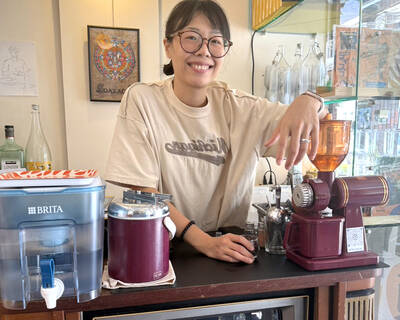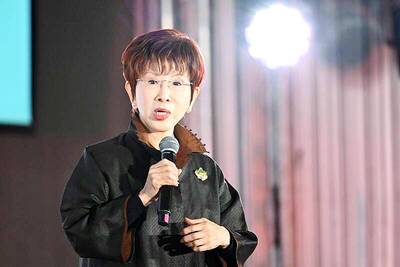International Community Radio Taipei (ICRT, 台北國際社區廣播電台), which turns 35 years old today, is on a campaign to connect with more listeners online, said general manager Tim Berge.
“If you’re under a certain age these days, you probably don’t have a radio. One thing that’s hurting us is that we don’t have our own app to get directly to those ears,” he said.
By year’s end, ICRT will launch a mobile app featuring live streaming and on-demand access to any of its shows through the Internet radio network TuneIn.

Photo courtesy of ICRT
The service will join “ICRT Daily News,” a dedicated English-learning app released late last month for iPhone and currently under development for Android.
“We’re also making our Web site mobile-friendly. Traditionally our Web site has been flash-based, which is not friendly to cell phones,” Berge said. “This way even if you don’t download our app, you can listen directly, too.”
By migrating to digital platforms, ICRT hopes to reach its stronghold audiences — cities like Taipei with relatively low rates of car ownership and high rates of smartphone uptake.

Photo courtesy of ICRT
The station is also looking to reach parts of Taiwan, for instance Yangmei (楊梅) in Taoyuan County, where the terrain weakens signals from one of its four transmitters.
“Taiwan is a difficult place to broadcast in because of all the mountains,” he said. “There are lots of little pockets in Taiwan where it’s difficult for people to listen to us, even though Taiwan is not that big ... What we want to do with our app is to fill in those holes.”
‘DON’T NEED RADIO LIKE YOU USED TO’

Photo courtesy of ICRT
ICRT came into existence shortly after the US broke ties with the Republic of China in January 1979.
As troops rolled out, the US military sold its Armed Forces Network Radio Taiwan to Taiwan’s Government Information Office for a dollar, and the station began a new life as ICRT on April 16, 1979.
For the next 15 years, ICRT was able to coast on a program of US billboard hits and international news, which it broadcast on an AM and FM channel.

Photo courtesy of ICRT
“Basically, if you went to the US during that time and turned on the station, that sound was what we sounded like,” said Berge, who arrived in 1991 as a news broadcaster who also did traffic reports.
But in January 1993, the central government lifted its ban on new radio stations, going on to approve 46 new stations across Taiwan on Dec. 24, 1994.
ICRT found itself floundering: Within the next few years, it had taken the AM channel permanently off-air and severely downsized its FM.

Photo courtesy of ICRT
“People hadn’t been listening to us for English per se, but they were listening for English music ... Then Hit FM (台北之音) and UFO Radio (飛碟聯播網) came — all these stations started playing western music,” he said.
More recently, rapid Internet penetration has also been chipping away at ICRT’s core audience.
“You don’t need radio like you used to,” Berge said.
“In the old days, the DJs would spend a lot of time talking about what was going on overseas. Because there was limited information, we were kind of filling a void. But now there is all sorts of information on the Internet … And it’s been constant change all these years.”
STATE OF THE STATION
Since the end of Martial Law and subsequent media liberalization, ICRT has tested many measures in the bid to stay competitive, at times alienating its audience.
It’s tilted toward more music and less banter, then back to more banter and less music. In the early 2000s, the station had a brief and badly-received experiment with a bilingual format, with DJs entertaining on a mix of English and Mandarin in hopes of appealing to a broader audience.
Today, ICRT works out of a modest office in Sinjhuang (新莊), a remote home it found in 2009 in the face of economic and industry-wide recessions.
Like most of Taiwan’s legacy media outlets, ICRT limits first-hand reporting to local — even hyper-local — news, which has turned out to be most pragmatic use of a lean budget.
ICRT has also joined traditional outlets in deepening its dependence on advertising for primary revenue. Today, the station’s two producers mainly make commercials, such as English lessons sponsored by cram schools and “We Love Hakka,” a segment for the Hakka Affairs Council (客家委員會).
But for Berge, surviving in the digital age also means curating a particular kind of content that can become a hit online — “content that can be podcast or replayed,” he said.
This includes Taiwan Talk, a twice-weekly local interview program introduced in 2012.
Also since 2012, ICRT has released four original hour-long dramas in collaboration with Red Room Radio Redux. Starting this year, the station will air Ted Radio Hour, a co-production by TED and the Washington-based NPR.
“The idea is we’re trying to provide more interesting, informational content that is thought-provoking ... A lot of stuff, like DJ playing music and news, is not something people need to go back to and listen to again,” he said.
Today, as ICRT continues to grope for a workable business model in a shifting media landscape, letters from unhappy listeners keep arriving — notably last year after mainstay Ron Stuart left the DJ lineup.
“We were changing our approach into more programming like TED, more BBC stuff, info that people could use. We didn’t need that many DJs,” Berge said.
Yet despite hardships and its constantly evolving face, 35 years after parting ways with the US military, ICRT has stabilized at No. 6 on the AC Nielsen rankings for radio. It is still running an uninterrupted broadcast of Taiwan’s only English-language program.
“To be honest, you’re never going to satisfy everyone in your audience. There is always going to be people who will feel that you should be more like you were in the past,” Berge said.
“But we didn’t have competition in the past. Being independent and self-sufficient — it means we have to react to the market and learn to live with it.”

Cheng Ching-hsiang (鄭青祥) turned a small triangle of concrete jammed between two old shops into a cool little bar called 9dimension. In front of the shop, a steampunk-like structure was welded by himself to serve as a booth where he prepares cocktails. “Yancheng used to be just old people,” he says, “but now young people are coming and creating the New Yancheng.” Around the corner, Yu Hsiu-jao (饒毓琇), opened Tiny Cafe. True to its name, it is the size of a cupboard and serves cold-brewed coffee. “Small shops are so special and have personality,” she says, “people come to Yancheng to find such treasures.” She

Late last month Philippines Foreign Affairs Secretary Theresa Lazaro told the Philippine Senate that the nation has sufficient funds to evacuate the nearly 170,000 Filipino residents in Taiwan, 84 percent of whom are migrant workers, in the event of war. Agencies have been exploring evacuation scenarios since early this year, she said. She also observed that since the Philippines has only limited ships, the government is consulting security agencies for alternatives. Filipinos are a distant third in overall migrant worker population. Indonesia has over 248,000 workers, followed by roughly 240,000 Vietnamese. It should be noted that there are another 170,000

Hannah Liao (廖宸萱) recalls the harassment she experienced on dating apps, an experience that left her frightened and disgusted. “I’ve tried some voice-based dating apps,” the 30-year-old says. “Right away, some guys would say things like, ‘Wanna talk dirty?’ or ‘Wanna suck my d**k?’” she says. Liao’s story is not unique. Ministry of Health and Welfare statistics show a more than 50 percent rise in sexual assault cases related to online encounters over the past five years. In 2023 alone, women comprised 7,698 of the 9,413 reported victims. Faced with a dating landscape that can feel more predatory than promising, many in

Former Chinese Nationalist Party (KMT) chairwoman Hung Hsiu-chu’s (洪秀柱) attendance at the Chinese Communist Party’s (CPP) “Chinese People’s War of Resistance Against Japanese Aggression and the World Anti-Fascist War” parade in Beijing is infuriating, embarrassing and insulting to nearly everyone in Taiwan, and Taiwan’s friends and allies. She is also ripping off bandages and pouring salt into old wounds. In the process she managed to tie both the KMT and the Democratic Progressive Party (DPP) into uncomfortable knots. The KMT continues to honor their heroic fighters, who defended China against the invading Japanese Empire, which inflicted unimaginable horrors on the